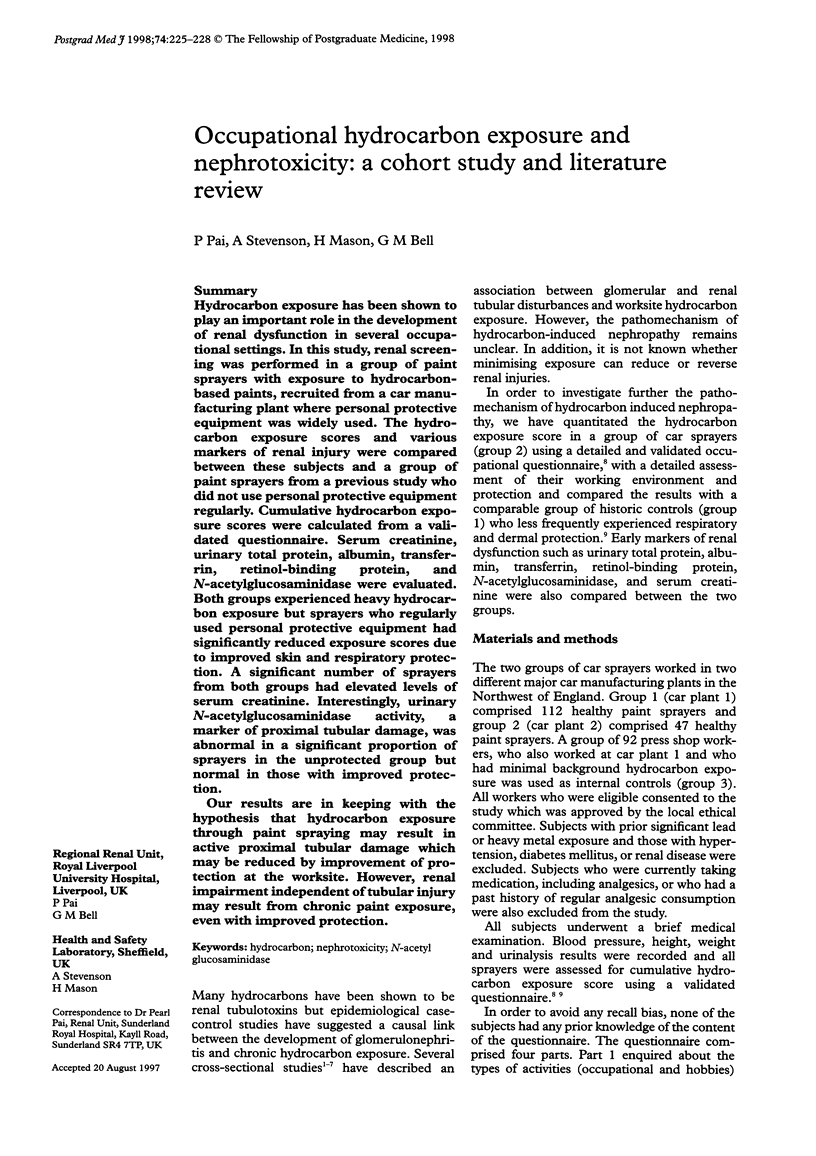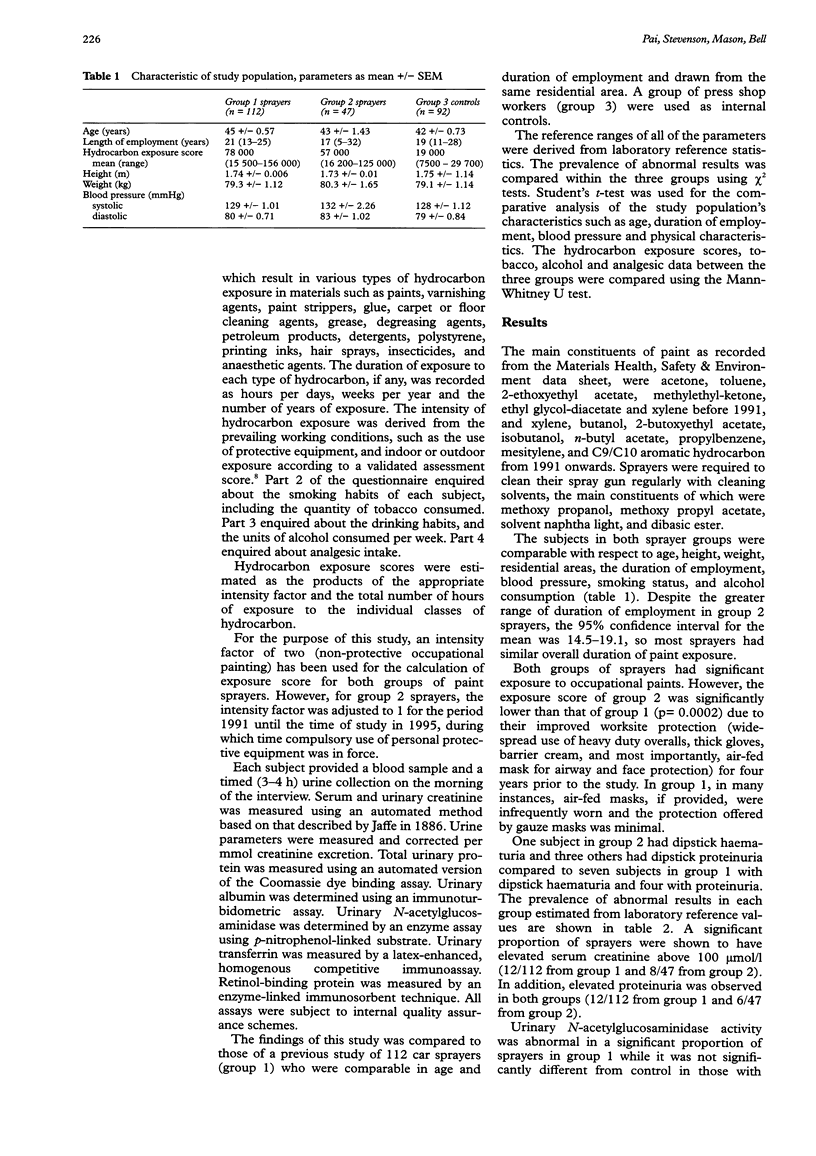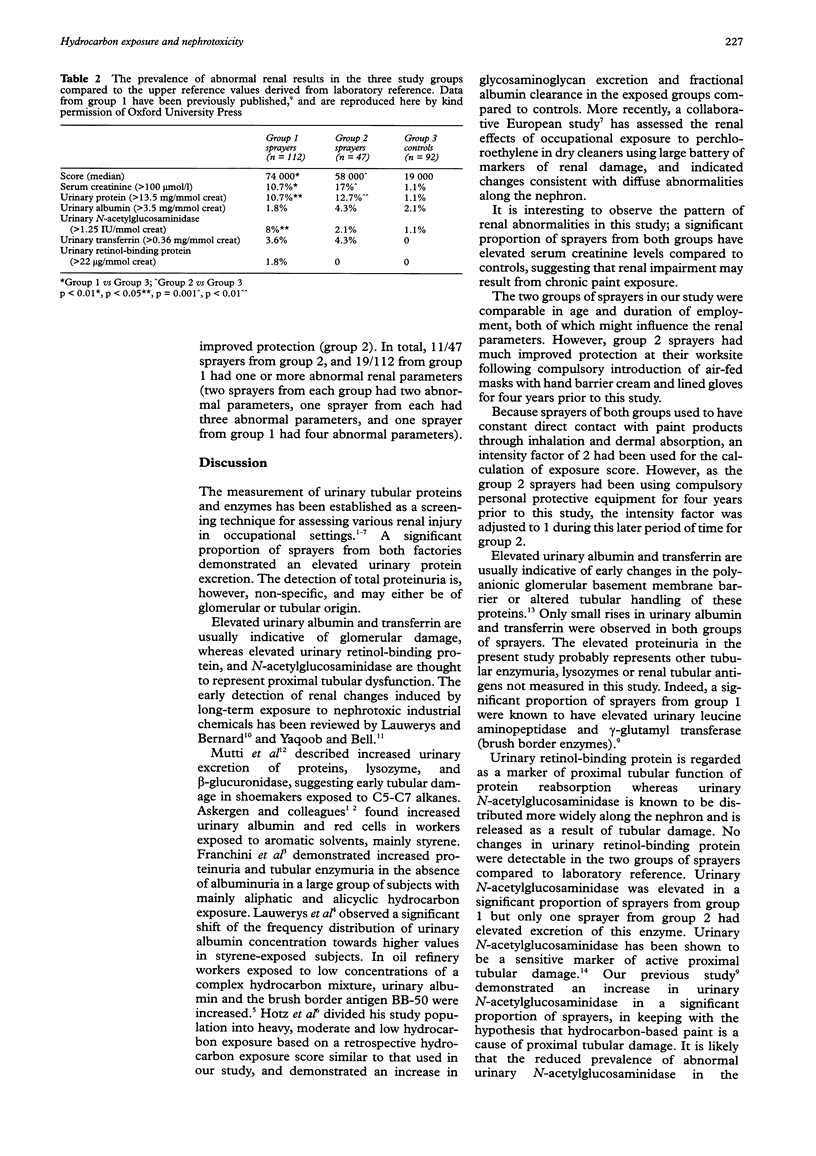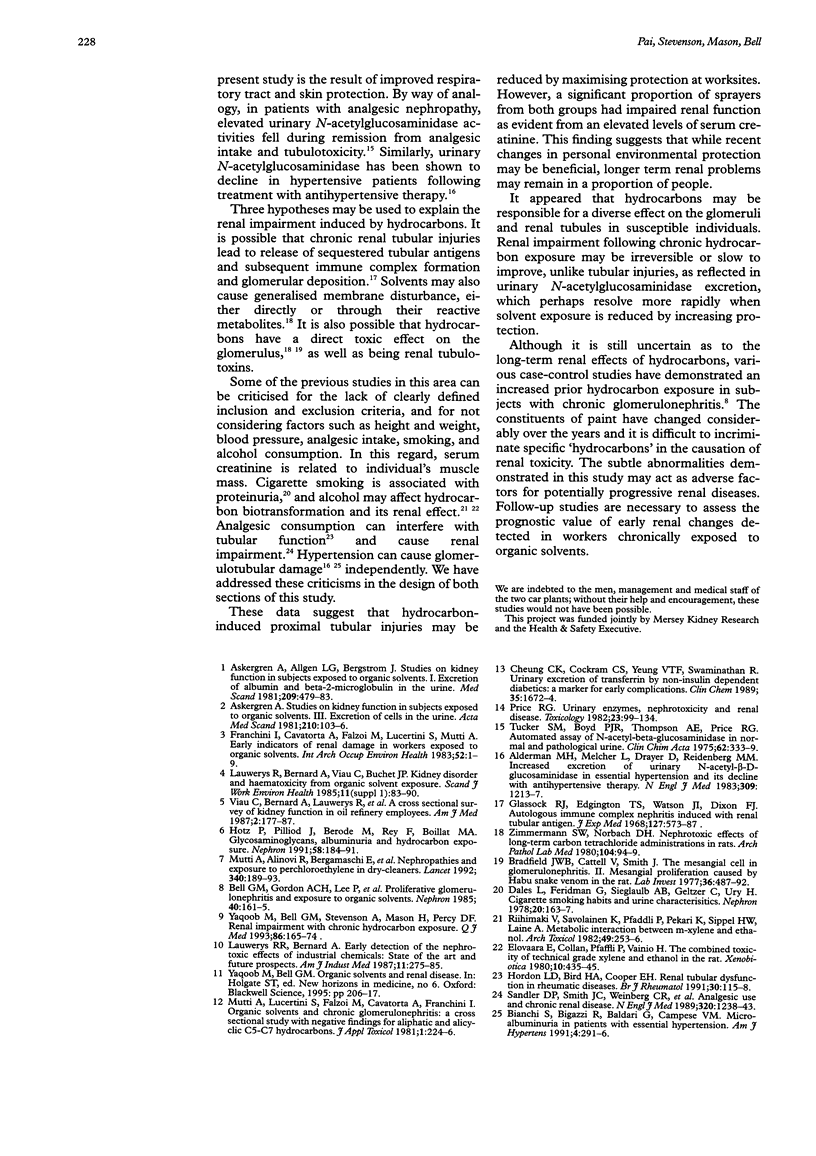Abstract
Hydrocarbon exposure has been shown to play an important role in the development of renal dysfunction in several occupational settings. In this study, renal screening was performed in a group of paint sprayers with exposure to hydrocarbon-based paints, recruited from a car manufacturing plant where personal protective equipment was widely used. The hydrocarbon exposure scores and various markers of renal injury were compared between these subjects and a group of paint sprayers from a previous study who did not use personal protective equipment regularly. Cumulative hydrocarbon exposure scores were calculated from a validated questionnaire. Serum creatinine, urinary total protein, albumin, transferrin, retinol-binding protein, and N-acetylglucosaminidase were evaluated, Both groups experienced heavy hydrocarbon exposure but sprayers who regularly used personal protective equipment had significantly reduced exposure scores due to improved skin and respiratory protection. A significant number of sprayers from both groups had elevated levels of serum creatinine. Interestingly, urinary N-acetylglucosaminidase activity, a marker of proximal tubular damage, was abnormal in a significant proportion of sprayers in the unprotected group but normal in those with improved protection. Our results are in keeping with the hypothesis that hydrocarbon exposure through paint spraying may result in active proximal tubular damage which may be reduced by improvement of protection at the worksite. However, renal impairment independent of tubular injury may result from chronic paint exposure, even with improved protection.
Full text
PDF



Selected References
These references are in PubMed. This may not be the complete list of references from this article.
- Alderman M. H., Melcher L., Drayer D. E., Reidenberg M. M. Increased excretion of urinary N-acetyl-beta-glucosaminidase in essential hypertension and its decline with antihypertensive therapy. N Engl J Med. 1983 Nov 17;309(20):1213–1217. doi: 10.1056/NEJM198311173092004. [DOI] [PubMed] [Google Scholar]
- Askergren A., Allgën L. G., Karlsson C., Lundberg I., Nyberg E. Studies on kidney function in subjects exposed to organic solvents. I. Excretion of albumin and beta-2-microglobulin in the urine. Acta Med Scand. 1981;209(6):479–483. doi: 10.1111/j.0954-6820.1981.tb11633.x. [DOI] [PubMed] [Google Scholar]
- Askergren A. Studies on kidney function in subjects exposed to organic solvents. III. Excretion of cells in the urine. Acta Med Scand. 1981;210(1-2):103–106. doi: 10.1111/j.0954-6820.1981.tb09783.x. [DOI] [PubMed] [Google Scholar]
- Bell G. M., Gordon A. C., Lee P., Doig A., MacDonald M. K., Thomson D., Anderton J. L., Robson J. S. Proliferative glomerulonephritis and exposure to organic solvents. Nephron. 1985;40(2):161–165. doi: 10.1159/000183476. [DOI] [PubMed] [Google Scholar]
- Bianchi S., Bigazzi R., Baldari G., Campese V. M. Microalbuminuria in patients with essential hypertension. Effects of an angiotensin converting enzyme inhibitor and of a calcium channel blocker. Am J Hypertens. 1991 Apr;4(4 Pt 1):291–296. [PubMed] [Google Scholar]
- Bradfield J. W., Cattell V., Smith J. The mesangial cell in glomerulonephritis. II. Mesangial proliferation caused by Habu snake venom in the rat. Lab Invest. 1977 May;36(5):487–492. [PubMed] [Google Scholar]
- Cheung C. K., Cockram C. S., Yeung V. T., Swaminathan R. Urinary excretion of transferrin by non-insulin-dependent diabetics: a marker for early complications? Clin Chem. 1989 Aug;35(8):1672–1674. [PubMed] [Google Scholar]
- Elovaara E., Collan Y., Pfäffli P., Vainio H. The combined toxicity of technical grade xylene and ethanol in the rat. Xenobiotica. 1980 Jun;10(6):435–445. doi: 10.3109/00498258009033778. [DOI] [PubMed] [Google Scholar]
- Franchini I., Cavatorta A., Falzoi M., Lucertini S., Mutti A. Early indicators of renal damage in workers exposed to organic solvents. Int Arch Occup Environ Health. 1983;52(1):1–9. doi: 10.1007/BF00380601. [DOI] [PubMed] [Google Scholar]
- Glassock R. J., Edgington T. S., Watson J. I., Dixon F. J. Autologous immune complex nephritis induced with renal tubular antigen. II. The pathogenetic mechanism. J Exp Med. 1968 Mar 1;127(3):573–588. doi: 10.1084/jem.127.3.573. [DOI] [PMC free article] [PubMed] [Google Scholar]
- Hordon L. D., Bird H. A., Cooper E. H. Renal tubular dysfunction in rheumatic diseases. Br J Rheumatol. 1991 Apr;30(2):115–118. doi: 10.1093/rheumatology/30.2.115. [DOI] [PubMed] [Google Scholar]
- Lauwerys R. R., Bernard A. Early detection of the nephrotoxic effects of industrial chemicals: state of the art and future prospects. Am J Ind Med. 1987;11(3):275–285. doi: 10.1002/ajim.4700110305. [DOI] [PubMed] [Google Scholar]
- Lauwerys R., Bernard A., Viau C., Buchet J. P. Kidney disorders and hematotoxicity from organic solvent exposure. Scand J Work Environ Health. 1985;11 (Suppl 1):83–90. [PubMed] [Google Scholar]
- Mutti A., Alinovi R., Bergamaschi E., Biagini C., Cavazzini S., Franchini I., Lauwerys R. R., Bernard A. M., Roels H., Gelpi E. Nephropathies and exposure to perchloroethylene in dry-cleaners. Lancet. 1992 Jul 25;340(8813):189–193. doi: 10.1016/0140-6736(92)90463-d. [DOI] [PubMed] [Google Scholar]
- Mutti A., Lucertini S., Falzoi M., Cavatorta A., Franchini I. Organic solvents and chronic glomerulonephritis: a cross-sectional study with negative findings for aliphatic and alicyclic C5-C7 hydrocarbons. J Appl Toxicol. 1981 Aug;1(4):224–226. doi: 10.1002/jat.2550010408. [DOI] [PubMed] [Google Scholar]
- Price R. G. Urinary enzymes, nephrotoxicity and renal disease. Toxicology. 1982;23(2-3):99–134. doi: 10.1016/0300-483x(82)90092-0. [DOI] [PubMed] [Google Scholar]
- Riihimäki V., Savolainen K., Pfäffli P., Pekari K., Sippel H. W., Laine A. Metabolic interaction between m-xylene and ethanol. Arch Toxicol. 1982 Mar;49(3-4):253–263. doi: 10.1007/BF00347873. [DOI] [PubMed] [Google Scholar]
- Sandler D. P., Smith J. C., Weinberg C. R., Buckalew V. M., Jr, Dennis V. W., Blythe W. B., Burgess W. P. Analgesic use and chronic renal disease. N Engl J Med. 1989 May 11;320(19):1238–1243. doi: 10.1056/NEJM198905113201903. [DOI] [PubMed] [Google Scholar]
- Tucker S. M., Boyd P. J., Thompson A. E., Price R. G. Automated assay of N-acetyl-beta-glucosaminidase in normal and pathological human urine. Clin Chim Acta. 1975 Jul 23;62(2):333–339. doi: 10.1016/0009-8981(75)90245-4. [DOI] [PubMed] [Google Scholar]
- Viau C., Bernard A., Lauwerys R., Buchet J. P., Quaeghebeur L., Cornu M. E., Phillips S. C., Mutti A., Lucertini S., Franchini I. A cross-sectional survey of kidney function in refinery employees. Am J Ind Med. 1987;11(2):177–187. doi: 10.1002/ajim.4700110207. [DOI] [PubMed] [Google Scholar]
- Yaqoob M., Bell G. M., Stevenson A., Mason H., Percy D. F. Renal impairment with chronic hydrocarbon exposure. Q J Med. 1993 Mar;86(3):165–174. [PubMed] [Google Scholar]
- Zimmerman S. W., Norbach D. H. Nephrotoxic effects of long-term carbon tetrachloride administration in rats. Arch Pathol Lab Med. 1980 Feb;104(2):94–99. [PubMed] [Google Scholar]


